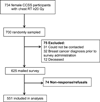Health care utilization, lifestyle, and emotional factors and mammography practices in the Childhood Cancer Survivor Study
- PMID: 26304504
- PMCID: PMC4633330
- DOI: 10.1158/1055-9965.EPI-14-1377
Health care utilization, lifestyle, and emotional factors and mammography practices in the Childhood Cancer Survivor Study
Abstract
Background: Women with a history of chest radiotherapy have an increased risk of breast cancer; however, many do not undergo annual recommended screening mammography. We sought to characterize the relationship between mammography and potentially modifiable factors, with the goal of identifying targets for intervention to improve utilization.
Methods: Of 625 female participants sampled from the Childhood Cancer Survivor Study, who were treated with chest radiotherapy, 551 responded to a survey about breast cancer screening practices. We used multivariate Poisson regression to assess several lifestyle and emotional factors, health care practices, and perceived breast cancer risk, in relation to reporting a screening mammogram within the last two years.
Results: Women who had a Papanicolaou test [prevalence ratio (PR): 1.77; 95% confidence interval (CI) 1.26-2.49], and who perceived their breast cancer risk as higher than the average woman were more likely to have had a mammogram (PR, 1.26; 95% CI, 1.09-1.46). We detected an attenuated effect of echocardiogram screening [PR, 0.70; 95% CI (0.52-0.95)] on having a mammogram among older women compared with younger women. Smoking, obesity, physical activity, coping, and symptoms of depression and somatization were not associated with mammographic screening.
Conclusion: Our findings suggest that compliance with routine and risk-based screening can be an important indicator of mammography in childhood cancer survivors. In addition, there is a need to ensure women understand their increased breast cancer risk, as a means to encouraging them to follow breast surveillance guidelines.
Impact: Screening encounters could be used to promote mammography compliance in this population.
©2015 American Association for Cancer Research.
Conflict of interest statement
Figures
References
-
- Kenney LB, Yasui Y, Inskip PD, Hammond S, Neglia JP, Mertens AC, et al. Breast cancer after childhood cancer: a report from the Childhood Cancer Survivor Study. Ann Intern Med. 2004;141:590–597. - PubMed
-
- Travis LB, Hill DA, Dores GM, Gospodarowicz M, van Leeuwen FE, Holowaty E, et al. Breast cancer following radiotherapy and chemotherapy among young women with Hodgkin disease. JAMA. 2003;290:465–475. - PubMed
-
- Hancock SL, Tucker MA, Hoppe RT. Breast cancer after treatment of Hodgkin's disease. J Natl Cancer Inst. 1993;85:25–31. - PubMed
Publication types
MeSH terms
Grants and funding
- U24 CA055727/CA/NCI NIH HHS/United States
- 8UL1TR000170-05/TR/NCATS NIH HHS/United States
- K05 CA160724/CA/NCI NIH HHS/United States
- R25CA92203/CA/NCI NIH HHS/United States
- K05CA160724/CA/NCI NIH HHS/United States
- R01CA134722/CA/NCI NIH HHS/United States
- R25 CA057711/CA/NCI NIH HHS/United States
- U24CA55727/CA/NCI NIH HHS/United States
- R21CA106972/CA/NCI NIH HHS/United States
- R21 CA106972/CA/NCI NIH HHS/United States
- R01 CA136783/CA/NCI NIH HHS/United States
- P30 CA008748/CA/NCI NIH HHS/United States
- P30 CA21765/CA/NCI NIH HHS/United States
- R01CA136783/CA/NCI NIH HHS/United States
- R25CA057711/CA/NCI NIH HHS/United States
- UL1 TR000170/TR/NCATS NIH HHS/United States
- R25 CA092203/CA/NCI NIH HHS/United States
- R01 CA134722/CA/NCI NIH HHS/United States
LinkOut - more resources
Full Text Sources
Medical
Research Materials


